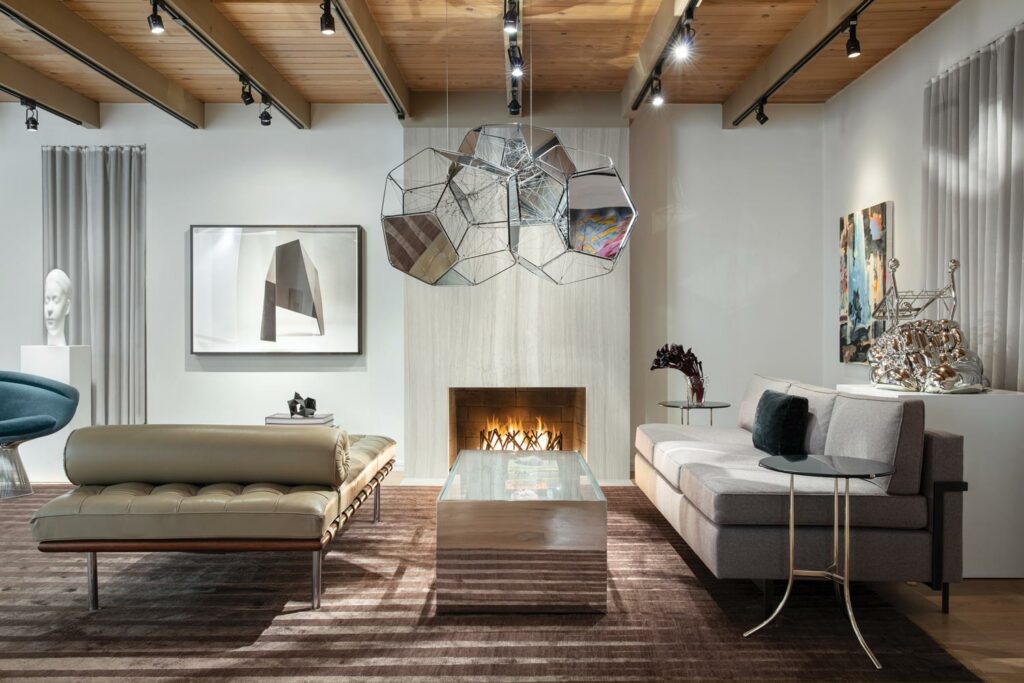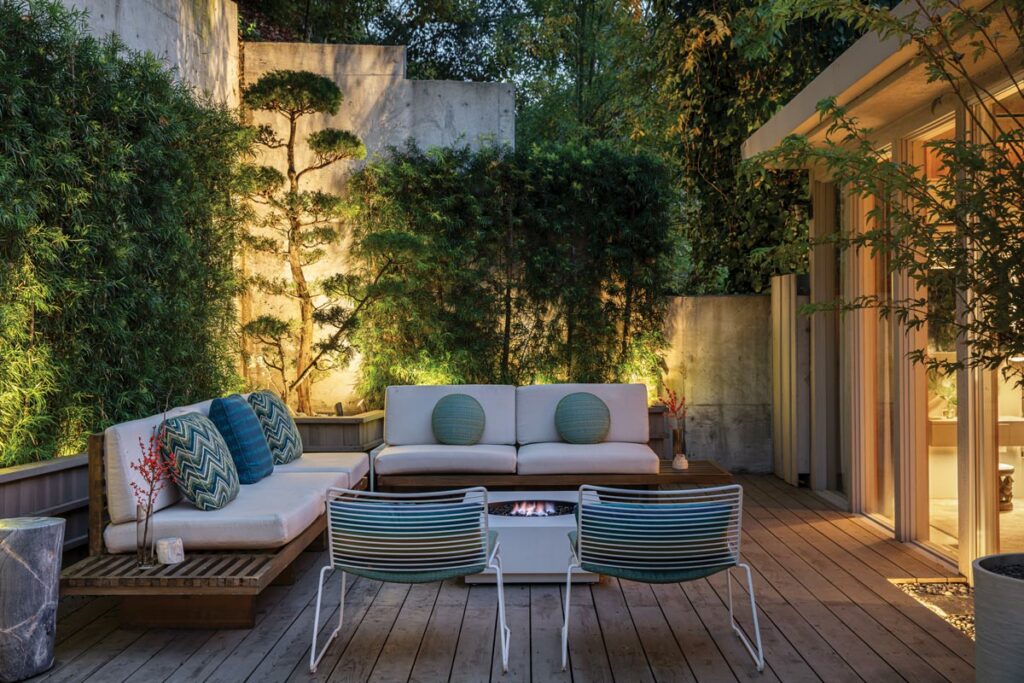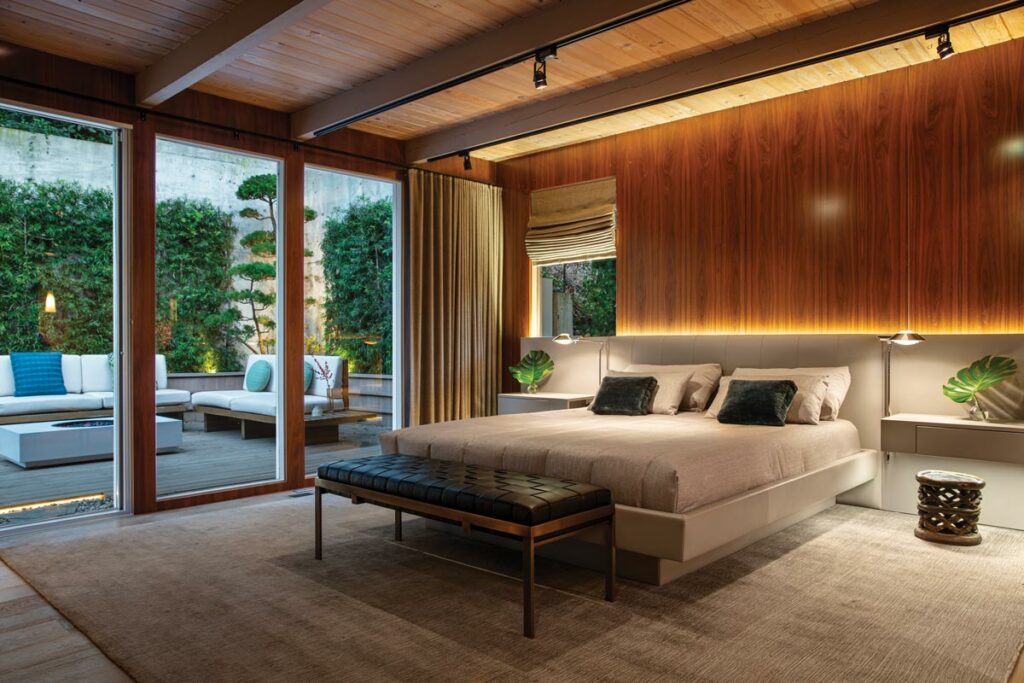Published as:
SOLO SHOW
Interior Design: James Magni
Text: Abigail Stone
Photography: Manolo Langis
With only themselves to please, designers turn their own homes into laboratories in which to explore their ideas. James Magni delights in this process; moving every few years keeps his creativity fit. “When I think a home is in pristine condition, I go look for my next challenge,” he says. The modest Benedict Canyon home, designed and built in 1964 by architect Marvin Beck, hid an airy two story interior behind its foreboding facade. Sliding doors opened up the rear to the majestic hillside. “I love to take on a project that’s been left unattended for a while but that has great bones,” he says. “I find that very fulfilling.”
Magni’s renovations received Beck’s blessing. “I brought it back to its original intent,” he says. The floor plan, revised to bring it in line with a modern lifestyle, opens up the public rooms. The bathrooms were updated. The entire primary suite was lined in walnut paneling, with a nearby bedroom commandeered to serve as a dressing room. The home’s former carport was enclosed to create a garage. A water feature was added to the back terrace.
Magni, whose fascination with art was early onset (he dreamed of becoming a sculptor, pivoted to architecture when it dawned on him that buildings were, in fact, giant sculptures, and eventually found himself seduced by interiors), let his art collection lead the interior design. The well-curated assemblage of work by important contemporary artists, built with the help of his longtime art consultant, Michael Thomas, demands center stage. While Magni obliges, the rooms, while spare and monochromatic, do not feel like a museum. Instead they radiate a subtle, steady warmth. “Our spaces are kind of feel-good spaces,” he says. Credit for that goes to his dexterous use of texture. “We work with glass and steel and concrete,” says Magni, “but we also bring in fine woods, luxurious fabrics and soft rugs.” These materials absorb light, turning the room’s focus towards their true purpose: the contemplation of art.
While Magni’s interiors have always been well-edited, here, given the confines of the home’s compact footprint, each item speaks with particular eloquence. In the living room, a Tomás Saraceno mobile (which visitors often mistake for a chandelier) dangles over a Magni Home Collection coffee table and sofa, flanked by Cedric Hartman side tables, and Mies Van Der Rohe’s Barcelona daybed. Covered in delicately colored, lush fabrics—parchment leather on the daybed, silvery gray Romo wool on the sofa—with a wool and silk rug by Mansour underfoot, the clean-lined pieces balance the impact of the art: Joel Morrison’s stainless steel Weather Balloon Trapped in a Shopping Cart; Jaume Plensa’s Sanna’s Frozen Dream (a white plaster head); prints from Erin Shirreff and April Gornik; and Annie Lapin’s That Is Here and There.
Brian Fahlstrom’s Interharmony dominates the dining area, its Carrara marble–topped Saarinen table surrounded by vintage midcentury dining chairs covered in a light Romo tweed. Its idyllic palette is balanced, in the nearby entry, by Kehinde Wiley’s mesmerising Angel Gabriel, a vivid painting by Jonathan Apgar and two Warren Platner chairs, linked by Magni Home Collection’s glass Jewel table. The color of the chair’s mohair upholstery, a deep variation of Magni’s favorite teal blue, is peppered throughout the space, a subtle thread tying it together. It’s in the collection of dishware displayed on the kitchen’s open shelving, on the lone pillow that decorates the living room sofa and, on the back terrace, it erupts on pillows that populate the custom sectional and the Sunbrella cushions on the lounge chairs.
That same hue also finds its echo in the primary suite, where it’s a singular deviation from the voluptuous finishes in shades of brown with which Magni has wrapped the entire room: the deep walnut-paneled walls and ceiling, a taupe leather bed, a woven dark leather bench, thick wool carpets and the worn wood of the intricately carved African stool. Save for Annie Lapin’s The Shiny, the room is also devoid of art. “It was about not being activated,” he says. The room’s visual tranquility allows him to focus on the books he devours each night.
But it’s in the TV room on the lower level, which is accessed by a spiral staircase that winds past a photograph by Mona Kuhn and a Seguso glass vase from the 1960s, that it struts its most brilliant variation. “I don’t do color,” Magni says. “But I wanted a room with color—so I did color!” The hue envelops a vintage chair, a lamp, an ottoman and a rocker, acting as a foil to the bright orange background on a 1960s figurative painting, the Magni Home Collection’s Moroccan sofa in a pale chartreuse and the raucous Missoni Liuwa rug. Wallcoverings from Romo’s Japanese series and a painting by Ross Bleckner mediate the energy of the various tints. “I like surprises in every project,” Magni says. “And it’s my own house; I can do what I want.” It’s a wild experiment for the refined designer. The result, like the rest of the home, is pure design alchemy. Magni Kalman Design, magnikalman.com




